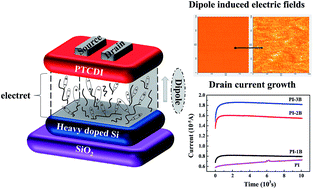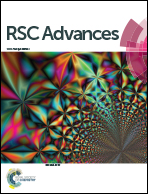Controlling carrier trapping and relaxation with a dipole field in an organic field-effect device†
Abstract
A series of polyimides (PIs) containing different weight ratios of polar piperazinyl and cholesterol side chains, denoted as PCPI, was synthesized in this study. These PIs were used as gate dielectrics of n-type organic field-effect transistors (OFETs) and as electrets of photo-assisted organic memories. The thermal properties of the PI/PCPI composite films were improved by increasing the spatial distribution of the PCPI molecules to form a thermally stable dielectric film. The performances of OFETs with PIs used as gate dielectrics, were gradually enhanced by increasing the mixture ratios of the PCPI molecules. A dipole field, which originated from the PCPI molecules into the OFETs, was introduced to observe the special phenomenon of output current growth over a long operation time. The application of these superior transistors with PCPI- and PI-mixed electrets to the field of organic memory resulted in a photo-assisted memory window of more than 38 V. The mechanisms of the carriers trapped in and released from the PI electrets were elucidated. Results showed that our devices possess excellent stability for OFETs and an extra-large memory window for organic memory devices.


 Please wait while we load your content...
Please wait while we load your content...